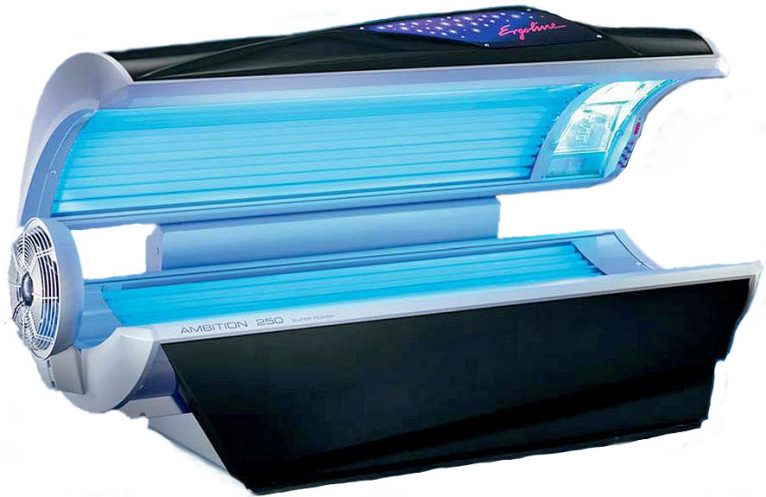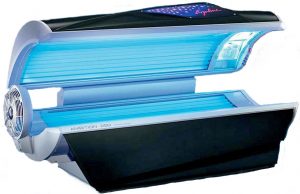Sunbeds can be healthful devices. By Marc Sorenson, EdD.

Sunbeds, also known as tanning beds, have many healthful properties. They produce vitamin D, strengthen bone and reduce the risk of major cancers. Yet, sunbeds are much maligned as being a major cause of melanoma. Thus, teens in many areas have been banned from using them by misguided legislation. In addition, tanning- salon owners must live in fear of government overreach that could put them out of business.
But new research shows that the attack on sunbeds is misguided.
Because of this uproar, a group of scientists (some dermatologists), led by Dr. Jörg Reichrath, did a thorough research review. Furthermore, they published their findings in the scientific journal Anticancer Research, which presented truth about melanoma and sunbeds. This information is most noteworthy since it is contrary to the prevailing papers that emanate from the Powers of Darkness. The Powers of Darkness are those who love to attack both sun exposure and sunbeds.
Especially relevant points regarding sunbeds and melanoma risk, from Anticancer Research:
- First of all, Reichrath and colleagues performed a systematic literature search. This research was undertaken to identify and evaluate research that investigated relationship of solarium use (sunbed use) and melanoma risk. And as a result, they stated the following: “We found no studies that demonstrate a causal relationship between moderate solarium use and melanoma risk.” In addition, they indicated that the quality of the observational studies was low and that bias may have existed.
- Another interesting finding was that although moderate sunbed use had no effect on melanoma, something else did affect melanoma. An unhealthy lifestyle involving extensive sunbathing, alcohol and smoking associated to a 20% increase in the disease. Also, the researchers mention that individuals with unhealthful lifestyles use tanning salons more often.
At this time, I must make a point. Those who are regularly in the sun have stronger bones and less cancer than sun avoiders. So I’m not sure what “extensive” sunbathing entailed. And, another point is this: As time spent in the sun has decreased profoundly in both Europe and the U.S., melanoma has increased exponentially. Read my book, Embrace the Sun, to see the discussion on this topic.
Could sunbeds actually decrease the risk of melanoma?
Another salient finding of the research review: A study from Europe showed that sunbed use was associated with a 30% reduced risk for developing melanoma. Reichrath and colleagues made this comment on that study: “Those findings indicate that solarium [sunbed] use may even have a protective effect.”
Sunbeds: beyond melanoma. Here are a few truths about sunbeds that are seldom discussed:
The transcendent sunbed study showed that during 20-years, women who used them reduced all-cause mortality by 23%. So let’s suppose that that there were some health problems with using sunbeds. That negative possibility pales in comparison to the remarkably reduced risk of death, does it not? And, I am not stating that there were negatives for sunbed use in this research.
What are some of the reasons that sunbed use is associated with a lower risk of all cause death?
Another investigation showed that sunbeds were associated with a reduced the risk of breast cancer.
In addition, research showed that sunbeds were associated with 90% higher vitamin D levels and significantly stronger bones.
Also, they are useful in treating psoriasis and other skin disorders.
Sunbeds are also useful in treating pain and in improving mood.
Finally, these devices have been shown to associate with lower clot risk.
The takeaway from all of these studies is that there is no credible research that melanoma is increased by using sunbeds. And, sunbeds have remarkably healthful effects. When receiving sun exposure or using sunbeds, be sure not to burn.
Happy sunning!
For more information, read the book, Embrace the Sun.
Is the sunbed a Gianus Bifrons (two-headed god)?
Sunbeds, Good or bad?
Recent research comes to the conclusion that indoor tanning is a Gianus Bifrons,[1] which is interpreted as a two-headed god. One head, according to these researchers, is an increase in various skin cancers (a dubious claim). The other head is the ability of sunbeds to produce large quantities of vitamin D, increasing serum vitamin D concentrations up to two fold. In addition, this increase in vitamin D, they believe, could lead to a decrease in myriad diseases.
The authors of the paper state the following: “Therefore, some favorable effects [of tanning beds] against the risk of developing many human diseases, including non-skin cancers, cannot be excluded at first glance, although they may not be only linked to [higher] vitamin D status.” They also go on to suggest that more research should be performed to determine if the unfavorable effects of indoor tanning on skin cancers may be outweighed by the favorable benefits of amelioration of low vitamin D levels.
This research ignored many research studies showing that regular, non-burning sun exposure is protective against melanoma. In my upcoming book, Embrace the sun, about 14 different research studies are cited. All of these studies demonstrate a positive effect of sun exposure. There are also positive effects of sun exposure and sunbed exposure, beyond the ability to produce vitamin D. Nitric oxide (NO) is produced by both. NO is a vasodilator that lowers blood pressure and reduces the risk of heart disease.
No increase in melanoma!
Perhaps the most important study to differentiate between the positive effects and negative effects of sunbed exposure is this one: A 20-year Swedish study demonstrated that women who used sunbeds were 23% less likely to die from any cause than women who did not use them.[2] This study also showed no increase in melanoma after the 20-year period.
So, what more do we need to know about the pros and cons of sunbed use?
Here are a few more positive effects of sunbeds on human health:
- Sunbed use reduces the risk of type 2 diabetes.[3]
- Sunbed use strengthens bone.[4]
- Sunbed use controls psoriasis and eczema.[5]
- Sunbed use reduces chronic pain.[6], [7]
- Sunbed use may help unborn children.[8]
- Sunbed use reduces the risk of clots.[9]
- Sunbed use is associated with lower breast-cancer risk.[10]
- Sunbed use reduces the risk of death.[11]
[1] Giuseppe Lippi*, 1, Gianfranco Cervellin†, Elisa Danese. Indoor Tanning a Gianus Bifrons:
Vitamin D and Human Cancer. Advances in Clinical Chemistry 2017;20:1-16
[2] Lindqvist PG, Epstein E, Landin-Olsson M, Ingvar C, Nielsen K, Stenbeck M, Olsson H. Avoidance of sun exposure is a risk factor for all-cause mortality: results from the Melanoma in Southern Sweden cohort. J Intern Med. 2014 Jul;276(1):77-86.
[3] P.G. Lindqvist, H. Olsson, M. Landin-Olsson, Are active sun exposure habits related
to lowering risk of type 2 diabetes mellitus in women, a prospective cohort
study?, Diabetes Res. Clin. Pract. 90 (2010):109-114.
[4] Tangpricha V, Turner A, Spina C, Decastro S, Chen TC, Holick MF. Tanning is associated with optimal vitamin D status (serum 25-hydroxyvitamin D concentration) and higher bone mineral density. Am J Clin Nutr 2004;80:1645-49.
[5] Radack KP, Farhangian ME, Anderson KL, Feldman SR. A review of the use of tanning beds as a dermatological treatment. Dermatol Ther (Heidelb). 2015 Mar;5(1):37-51.
[6] Kaur M, Feldman SR, Liguori A, Fleischer AB Jr. Indoor tanning relieves pain. Photodermatol Photoimmunol Photomed. 2005 Oct;21(5):278.
[7] Taylor SL, Kaur M, LoSicco K, Willard J, Camacho F, O’Rourke KS, Feldman SR. Pilot study of the effect of ultraviolet light on pain and mood in fibromyalgia syndrome. J Altern Complement Med. 2009 Jan;15(1):15-23.
[8] Bukhari, M. Quoted in London Times April 27, 2008.
[9] Lindqvist PG, Epstein E, Olsson H. Does an active sun exposure habit lower the risk of venous thrombotic events? A D-lightful hypothesis. J Thromb Haemost. 2009 Apr;7(4):605-10.
[10] Yang L, Veierød MB, Löf M, Sandin S, Adami HO, Weiderpass E. Prospective study of UV exposure and cancer incidence among Swedish women. J Intern Med. 2014 Jul;276(1):77-86
[11] Lindqvist PG, Epstein E, Landin-Olsson M, Ingvar C, Nielsen K, Stenbeck M, Olsson H. Avoidance of sun exposure is a risk factor for all-cause mortality: results from the Melanoma in Southern Sweden cohort. J Intern Med. 2014 Jul;276(1):77-86.


